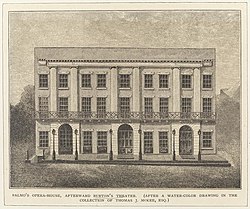
The Barber of Seville, or The Useless Precaution is an opera buffa in two acts composed by Gioachino Rossini with an Italian libretto by Cesare Sterbini. The libretto was based on Pierre Beaumarchais's French comedy The Barber of Seville (1775). The première of Rossini's opera took place on 20 February 1816 at the Teatro Argentina, Rome, with designs by Angelo Toselli.
This article is about music-related events in 1825.

Linda di Chamounix is an operatic melodramma semiserio in three acts by Gaetano Donizetti. The Italian libretto was written by Gaetano Rossi. It premiered in Vienna, at the Kärntnertortheater, on 19 May 1842.

Three New York City playhouses named Wallack's Theatre played an important part in the history of American theater as the successive homes of the stock company managed by actors James W. Wallack and his son, Lester Wallack. During its 35-year lifetime, from 1852 to 1887, that company developed and held a reputation as the best theater company in the country.

Joyce DiDonato is an American lyric-coloratura mezzo-soprano. She is notable for her interpretations of operas and concert works in the 19th-century romantic era in addition to works by Handel and Mozart.
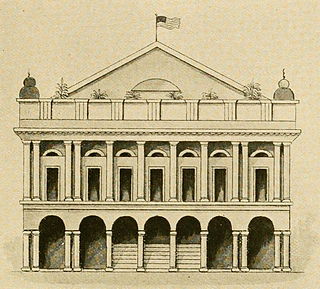
The Théâtre d'Orléans was the most important opera house in New Orleans in the first half of the 19th century. The company performed in French and gave the American premieres of many French operas. It was located on Orleans Street between Royal and Bourbon. The plans for the theatre were drawn up by Louis Tabary, a refugee from the French colony of Saint-Domingue (Haiti). Construction began in 1806, but the opening was delayed until October 1815. After a fire, it was rebuilt and reopened in 1819, led by another émigré from Saint-Domingue, John Davis. Davis became one of the major figures in French theatre in New Orleans. The theatre was destroyed by fire in 1866, but the ballroom is still used.
Detroit Opera is the principal opera company in Michigan, US. The company is based in Detroit, where it performs in the Detroit Opera House. Prior to February 28, 2022, the company was named Michigan Opera Theatre.
Gaetano Bavagnoli (1879–1933) was an Italian conductor who was particularly known for his work within the field of opera. He was mainly active within Italy's major opera houses during the first third of the 20th century; although he did conduct at important international stages like the Metropolitan Opera in New York City and the Royal Opera House in London as well. He also worked as a voice teacher and was notably the instructor of opera singers Emanuel Kopecky, Lina Pagliughi, and Aureliano Pertile.
Timothy Nolen is an American actor and baritone who has had an active career in operas, musicals, concerts, plays, and on television for over four decades. He was notably the second actor to play the title role in The Phantom of the Opera on Broadway.

Adelaide Borghi-Mamo was an Italian operatic mezzo-soprano who had an active international career from the 1840s through the 1880s. She was married to tenor Michele Mamo and their daughter, soprano Erminia Borghi-Mamo, also had a successful singing career.

Dolores Mae Wilson was an American coloratura soprano who had an active international opera career from the late 1940s through the early 1960s. Beginning her career with major theatres in Europe, she performed in six seasons at the Metropolitan Opera in New York City during the 1950s. She is perhaps best known for originating the title role in the world premiere of Douglas Moore's The Ballad of Baby Doe at the Central City Opera in 1956. After abandoning her opera career, she embarked on a second career as a musical theatre actress; making several appearances on Broadway in the following decades.
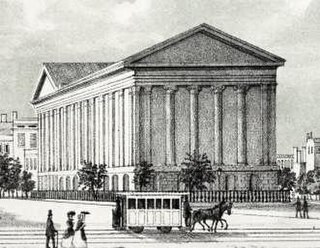
The Astor Opera House, also known as the Astor Place Opera House and later the Astor Place Theatre, was an opera house in Manhattan, New York City, located on Lafayette Street between Astor Place and East 8th Street. Designed by Isaiah Rogers, the theater was conceived by impresario Edward Fry, the brother of composer William Henry Fry, who managed the opera house during its entire history.
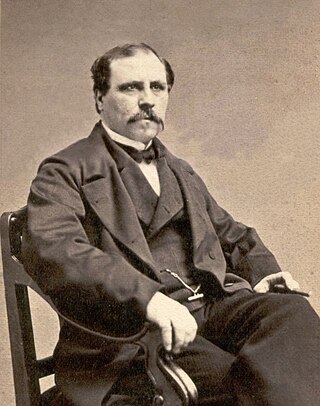
Robert Auguste Stoepel was a German-born American composer and conductor. His compositions include Hiawatha, a symphony for orchestra and vocal soloists, as well as incidental music for plays, piano works, songs, and several operas. Born in Berlin, Stoepel worked in Paris and London, but spent a large portion of his career in New York City where he died at the age of 66. From 1857 until their separation in 1869, he was married to the actress Matilda Heron. Their daughter Bijou Heron was also an actress.
Stanford Olsen is an American tenor who has had an active international career in operas and concerts since 1983. He has sung with several of the world's leading opera companies, including the Deutsche Oper Berlin, La Scala and the Royal Opera, London. He was a regular performer at the Metropolitan Opera from 1986 until 1997 where he gave more than 160 performances. A specialist in light lyric tenor roles, he excelled in the operas of Mozart, Bellini, Donizetti, and Gioachino Rossini. After retiring from full-time performance in the late 1990s he became a faculty member at the Florida State University's College of Music, where he was Professor of Voice and Lucille P. and Elbert B. Shelfer Eminent Scholar. He joined the faculty at the University of Michigan School of Music, Theatre & Dance in 2012. In 2015 he was appointed Director of the Castleton Festival's Artist Training Seminar. He continues to perform on the concert platform in addition to his teaching and coaching.

Elena D'Angri Vitturi was a Greek-born operatic contralto of Italian origin who was active in the mid-19th century in European opera houses and in the United States.

Pretty Yende is a South African operatic soprano. She has performed leading roles at opera houses internationally, including La Scala and the Metropolitan Opera. She performed at the coronation of Charles III and Camilla.
The Max Maretzek Italian Opera Company was a touring American opera company that performed throughout the United States from 1849 to 1878. The first major opera company in Manhattan and one of the first important companies in the United States, it had a long association with the Academy of Music in New York City where it presented an annual season of opera from 1854 until the company's demise in 1878. There the company performed the United States premieres of Rigoletto, Il trovatore, and La traviata among other works.
Delores Ziegler is an American mezzo-soprano who has had an active international performance career since the late 1970s. A former resident artist at the Cologne Opera, she has performed leading roles with many of the world's best opera houses, including La Scala, the Lyric Opera of Chicago, the Metropolitan Opera, the San Francisco Opera, and the Vienna State Opera. She is currently a professor of voice at the University of Maryland. While she has performed a broad repertoire, she is widely admired for her performances in operas by Wolfgang Amadeus Mozart and Richard Strauss; particularly Cherubino in The Marriage of Figaro, Dorabella in Così fan tutte, Idamante in Idomeneo, and Octavian in Der Rosenkavalier.
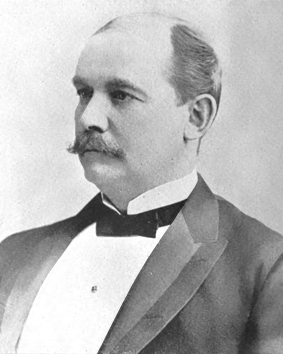
Abbey, Schoeffel and Grau was a US theatre management and production firm, active from 1880 until 1896. The partners were Henry E. Abbey, John B. Schoeffel and Maurice Grau. Abbey and Schoeffel had been in partnership since 1876, and joined forces with Grau in 1882. They managed and ran a number of theatres in New York and Boston, including the Metropolitan Opera House in 1883-4 and from 1891 to 1896, when Abbey died. Schoeffel and Grau remained at the Met until 1903.
Françoise Garner is a French soprano.
